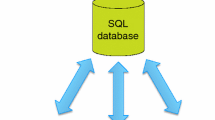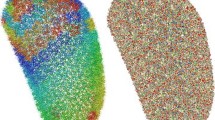Abstract
Research on biology has seen significant advances with the use of molecular dynamics (MD) simulations. The MD methodology enables explanation and discovery of molecular mechanisms in a wide range of natural processes and biological systems. The need to readily share the ever-increasing amount of MD data has been hindered by the lack of specialized bioinformatic tools. The difficulty lies in the efficient management of the data, i.e., in sending and processing 3D information for its visualization. In this work, we present HTMoL, a plug-in-free, secure GPU-accelerated web application specifically designed to stream and visualize MD trajectory data on a web browser. Now, individual research labs can publish MD data on the Internet, or use HTMoL to profoundly improve scientific reports by including supplemental MD data in a journal publication. HTMoL can also be used as a visualization interface to access MD trajectories generated on a high-performance computer center directly. Furthermore, the HTMoL architecture can be leveraged with educational efforts to improve learning in the fields of biology, chemistry, and physics.




Similar content being viewed by others
Data availability
HTMoL is available free of charge for academic use. All major browsers are supported. Online documentation, available at the HTMoL website http://htmol.tripplab.com, includes instructions for download, installation, configuration, and examples.
References
Perilla JR, Goh BC, Cassidy CK, Liu B, Bernardi RC, Rudack T, Yu H, Wu Z, Schulten K (2015) Curr Opin Struct Biol 31:64–74
Venable RM, Brown FL, Pastor RW (2015) Chem Phys Lipids 192:60–74
Wang X, Wang Y, Zheng L, Chen J (2014) Curr Med Chem 21:1968–1975
Zhao H, Caflisch A (2015) Eur J Med Chem 91:4–14
Aci-Sèche S, Ziada S, Braka A, Arora R, Bonnet P (2016) Future Med Chem 8:545–566
Bernardi RC, Melo MC, Schulten K (1850) Biochim Biophys Acta 2015:872–877
Weng J, Wang W (2014) Adv Exp Med Biol 805:305–329
Kalyaanamoorthy S, Chen YP (2014) Prog Biophys Mol Biol 114:123–136
Vlachakis D, Bencurova E, Papangelopoulos N, Kossida S (2014) Adv Protein Chem Struct Biol 94:269–313
Abraham MJ, Murtola T, Schulz R, Pall S, Smith JC, Hess B, Lindahl E (2015) SoftwareX 1–2:19–25
Brooks BR (2009) J Comput Chem 30:1545–1614
Salomon-Ferrer R, Case DA, Walker RC (2013) Wiley Interdiscip Rev: Comput Mol Sci 3:198–210
Phillips JC, Braun R, Wang W, Gumbart J, Tajkhorshid E, Villa E, Chipot C, Skeel RD, Kalac L, Schulten K (2005) J Comput Chem 26:1781–1802
Humphrey W, Dalke A, Schulten K (1996) J Mol Graphics 14:33–38
Schrödinger LLC (2015) The PyMOL Molecular Graphics System, Version 2.0. https://pymol.org/
Smarr LL, Chien AA, DeFanti T, Leigh J, Papadopoulos PM (2003) Commun ACM 46:58–67
Vishwanath V, Burns R, Leigh J, Seablom M (2009) Future Gener Comput Syst 25:184–191
Renambot L et al (2004) Sage: the scalable adaptive graphics environment. In: Proceedings of WACE. pp 2004–2009
Yuan S, Chan HS, Hu Z (2017) Trends Biotechnol 35:559–571
Hanson RM, Prilusky J, Renjian Z, Nakane T, Sussman JL (2013) Isr J Chem 53:207–216
Mwalongo F, Krone M, Becher M, Reina G, Ertl T (2016) Graph Models 88:57–65
Grottel S, Krone M, Mller C, Reina G, Ertl T (2015) IEEE Trans Visual Comput Graphics 21:201–214
Tiemann JKS, Guixa-Gonzalez R, Hildebrand PW, Rose AS, Hildebrand PW (2017) Nat Methods 14:1123–1124
Rose AS, Hildebrand PW (2015) Nucleic Acids Res 43:W576–W579
Kovachev D, Yu T, Klamma R (2012) Adaptive computation offloading from mobile devices into the cloud. In: 2012 IEEE 10th International symposium on parallel and distributed processing with applications (ISPA), pp 784–791
Deng S, Huang L, Taheri J, Zomaya AY (2015) IEEE Trans Parallel Distrib Syst 26:3317–3329
Hernandez IMT, Viveros AM, Rubio EH (2013) Analysis for the design of open applications on mobile devices. In: International Conference on Electronics, Communications and Computing (CONIELECOMP) 2013. pp 126–131
Noda-Garcia L, Camacho-Zarco AR, Medina-Ruiz S, Gaytan P, Carrillo-Tripp M, Fulop V, Barona-Gomez F (2013) Mol Biol Evol 30:2024–34
Antillon A et al (2016) PLoS ONE 11:e0162171
Carrillo-Tripp M, Feller SE (2005) Biochemistry 44:10164–10169
McGibbon RT, Beauchamp KA, Harrigan MP, Klein C, Swails JM, Hernández CX, Schwantes CR, Wang L-P, Lane TJ, Pande VS (2015) Biophys J 109:1528–1532
Acknowledgements
The authors want to acknowledge all the persons involved in the review process. Their comments have helped to greatly improve this report and the functionality of the tool.
Funding
This work has been supported by the Consejo Nacional de Ciencia y Tecnología México (Grant Number 132376 to M.C.-T.).
Author information
Authors and Affiliations
Corresponding author
Rights and permissions
About this article
Cite this article
Carrillo-Tripp, M., Alvarez-Rivera, L., Lara-Ramírez, O.I. et al. HTMoL: full-stack solution for remote access, visualization, and analysis of molecular dynamics trajectory data. J Comput Aided Mol Des 32, 869–876 (2018). https://doi.org/10.1007/s10822-018-0141-y
Received:
Accepted:
Published:
Issue Date:
DOI: https://doi.org/10.1007/s10822-018-0141-y




